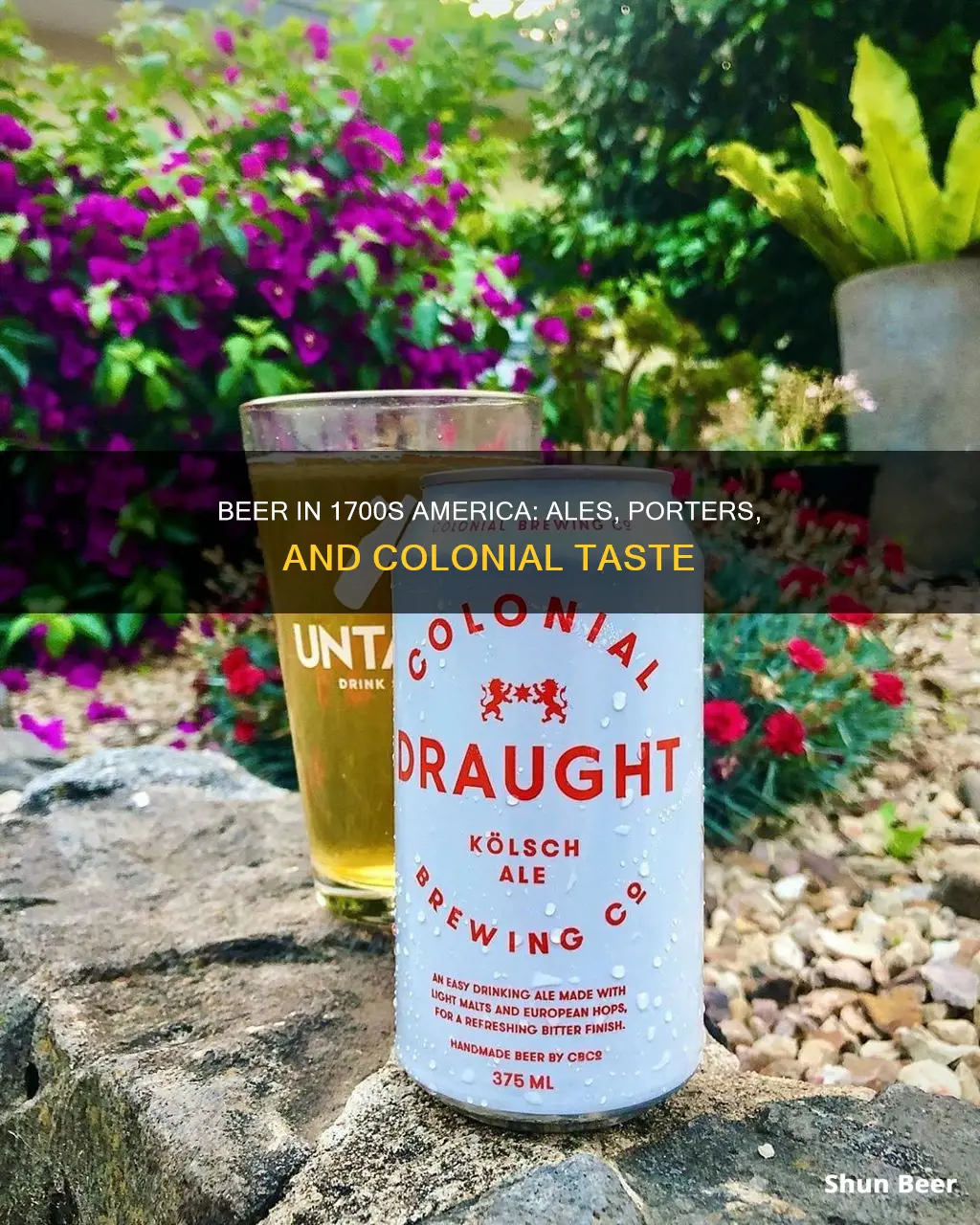
Beer was a staple in the diets of many Americans in the 1700s. In fact, beer was so important that the Pilgrims' unplanned landing at Plymouth Rock was attributed to a shortage of beer, which led them to settle for the bitter conditions of New England. Beer was also a common reward for workers, with tradesmen often receiving a bucket of beer as a standard part of their workday.
By 1770, the American brewing industry was well-established, with local breweries sprouting up throughout the colonies and experienced brewmasters being recruited from London. The beer brewed in the 1700s was likely to be ale, as it was easier to produce than other types of beer. Ale is produced by yeast that ferments best at about 60° F, a temperature that was more easily maintained during that time.
The ingredients used in the brewing process varied, but typically included water, grain (usually barley, although corn, oats, wheat, and rye were also used), sugar (often in the form of molasses or honey), and hops, which gave the ale its characteristic scent and flavor.
The brewing process involved several steps, including malting the grain, soaking the malt in a mash tub, separating the liquid (wort), boiling the wort with hops and other ingredients, cooling the mixture, and finally, adding yeast to begin the fermentation process.
While the specific types of beer consumed in the 1700s may have varied, one thing is clear: beer played a significant role in the lives of Americans during that time.
| Characteristics | Values |
|---|---|
| Main ingredients | Barley, maize, birch sap, water, hops, spruce, pumpkin, molasses, corn, wheat, oats, rye, Indian corn, persimmons, green cornstalks, pine tops, spruce trees, bran, ginger, sugar, yeast, sassafras or pine |
| Alcohol content | High |
| Served in | Standard half-pint, pint or quart vessels, waxed leather tankards known as "black jacks" |
| Price | Not more than one penny a quart |
| Production | Home-brewed or brewed in local breweries |
What You'll Learn
- Beer was made from maize, birch sap, water, molasses, sassafras, pine, pumpkins, corn, wheat, oats, rye, and barley
- Beer was drunk from waxed leather tankards known as black jacks
- Beer was also served in standard half-pint, pint, or quart vessels
- Beer was considered a healthy and nutritious beverage and was consumed at breakfast, lunch, and dinner
- Beer was often home-brewed

Beer was made from maize, birch sap, water, molasses, sassafras, pine, pumpkins, corn, wheat, oats, rye, and barley
Beer in the 1700s was made from a variety of ingredients, including maize, birch sap, and water, molasses, sassafras, pine, pumpkins, corn, wheat, oats, rye, and barley. Native Americans were the first to brew beer using maize, birch sap, and water, and they shared this recipe with the Pilgrims who landed at Plymouth Rock.
The early American settlers also learned to make beer from maize, and local breweries soon began to spring up across the colonies. Experienced brewmasters were even recruited from London. By 1770, the American brewing industry was well-established, and figures such as George Washington and Patrick Henry advocated for a boycott of English beer imports.
William Penn, the founder of Pennsylvania, Vermont, and New York, wrote that the beer in his colony was made from molasses, sassafras, or pine. Beer was also commonly brewed with barley, which has proven to be the world's most valued brewing ingredient. The word "beer" itself likely comes from the Anglo-Saxon word "baere," meaning barley.
In addition to barley, other grains used in brewing during the 1700s included corn, oats, wheat, and rye. The process of malting these grains was important, as it created the enzymes necessary for converting natural proteins into sugars that could be fermented by yeast to produce alcohol.
While beer was typically made from grains, early Americans also experimented with other ingredients. Persimmons, for example, were used to make beer in the southern and mid-Atlantic regions of the United States. Pumpkin beer was also brewed, though it never attained great popularity. Spruce was another common ingredient, often used in place of hops, providing bitterness and preservative qualities.
The brewing process in the 1700s involved choosing water of a pleasing taste, malting the grain, and adding sugar (usually in the form of molasses or honey), hops, and other ingredients. The mixture was then boiled, cooled, and sprinkled with yeast to begin the fermentation process. The resulting beverage could be consumed immediately or stored in barrels.
Beer and Booster Shots: What's Safe?
You may want to see also

Beer was drunk from waxed leather tankards known as black jacks
In the 1700s, beer was drunk from waxed leather tankards known as black jacks. These tankards were used to drink a variety of beers, including those made from maize, birch sap and water, and pumpkins. Beer was also brewed from barley, corn, oats, wheat, and rye.
The drinking culture in the 1700s was prominent, with alcohol considered a cure for the sick and a strengthener of the weak. Beer was drunk from the morning to the night, with many starting their day with a pick-me-up and ending it with a put-me-down. Beer was also used to lubricate social events such as christenings, weddings, and funerals.
The term small beer was used to describe home brews, which typically had lower alcohol content than commercially prepared "strong beer". Beer was also served in standard half-pint, pint, or quart vessels, and it was fashionable to melt down and recast old pewter mugs from England.
The act of drinking beer was so ingrained in the culture that it even played a role in the Revolutionary War. George Washington, the Commander of the Continental Army, ensured that his troops received a quart of beer with their daily rations.
The art of brewing was highly regarded, and experienced brewmasters were recruited from London to establish the American brewing industry. Brewing was also a common practice in households, with women typically responsible for producing beer for their families and servants.
The process of brewing beer involved choosing water with a pleasing taste, malting the grain, adding sugar and hops, boiling the mixture, cooling it, and adding yeast to begin the fermentation process. The final product was either consumed immediately or stored in barrels.
Beer Foam: To Drink or Not to Drink?
You may want to see also

Beer was also served in standard half-pint, pint, or quart vessels
Beer was an incredibly important beverage in 18th-century Britain and its colonies. In fact, it was so important that by law, beer had to be served in standard half-pint, pint, or quart vessels. Beer was also subject to price controls, with the Massachusetts Bay Colony legislature fixing the price of beer at "not more than one penny a quart".
The ubiquity of beer in the 1700s was due in part to a widespread distrust of water. Water could be contaminated and unsafe to drink, and even when it was safe, it could be full of mud and require time to settle. Beer, on the other hand, was seen as a healthy and nutritious beverage, fit for consumption at any time of day. It was also believed to have medicinal properties, with physicians claiming that hops helped with sleep and increased appetite.
Beer was also a popular drink because it was seen as a "lesser of two evils" compared to spirits or hard liquor. While beer did contain alcohol, it had far lower alcohol content than spirits. This made beer a popular choice for those who opposed drunkenness and alcoholism.
The popularity of beer also had to do with the fact that it was a traditional beverage in England and its colonies. Beer was consumed by all classes of society, from paupers to the Founding Fathers. George Washington, for example, was an accomplished brewmaster who maintained a private brewery at Mount Vernon. Thomas Jefferson, Samuel Adams, and James Madison also eagerly promoted America's fledgling brewing industry.
The standard serving size of beer in the 1700s was likely a welcome aspect of the beverage for thirsty colonists. However, it is important to note that the alcohol content of beer at the time is difficult to determine. While it is believed that most beers were fairly high in alcohol content, the exact percentage is hard to pinpoint due to variations in ingredients, malting processes, and brewing techniques.
Light Beer: Healthy Alternative or Just a Marketing Ploy?
You may want to see also

Beer was considered a healthy and nutritious beverage and was consumed at breakfast, lunch, and dinner
In the 1700s, beer was considered a healthy and nutritious beverage, consumed at breakfast, lunch, and dinner. Beer was believed to be a cure for sickness, a strengthener of the weak, and an enlivening drink for the aged. Beer was also thought to be a digestive aid and a source of increased strength.
Beer was so important to the colonists that it was consumed from dawn to dusk. It was drunk at all meals, as well as at social events such as christenings, weddings, funerals, trials, and election-day gatherings. It was also used to entice voters with free drinks and was served to workers in the fields, shoppers in stores, sailors at sea, and soldiers in camp.
The first European settlers in America initially struggled to brew beer due to the lack of suitable ingredients and the challenges of the New England climate. However, they soon learned from Native Americans how to make beer from maize, and local breweries began to spring up throughout the colonies. Experienced brewmasters were also recruited from London.
By the 1770s, the American brewing industry was well-established, with prominent figures such as George Washington and Patrick Henry advocating for a boycott of English beer imports. Beer was so integral to colonial life that the Boston Tea Party almost became the Boston Beer Party.
The process of brewing beer in the 1700s was quite different from modern methods. Beer was primarily made from malted barley, but corn, oats, wheat, and rye were also used. The grain was malted, sprouted, and dried in kilns before being added to the mixture. Sugar, usually in the form of molasses or honey, was added to nourish the yeast. Hops, the fruit of a vine-like plant related to the mulberry tree, gave the beer its characteristic scent and flavor.
The brewing process involved soaking the malt in a large wooden mash tub at low temperatures, separating it from the liquid, and boiling the resulting wort with hops and other ingredients. The mixture was then cooled, yeast was added, and the beer was either consumed immediately or stored in barrels.
While the specific ingredients and brewing techniques may have varied, beer was undoubtedly a significant part of daily life in colonial America, and its consumption was deeply ingrained in the cultural and social fabric of the time.
Understanding Inline Beer Filters: Mechanism and Functionality
You may want to see also

Beer was often home-brewed
Home-brewed beer was generally lower in alcohol than commercially prepared "strong beer", and was known as "small beer". George Washington's personal recipe for small beer, which was said to be superb, called for a generous measure of molasses. Other home-brewers used ingredients like persimmons, spruce, pumpkins, sassafras, and molasses.
Home-brewing was so common that William Penn wrote that the beer in his colony was made of "molasses... well boyled, with sassafras or pine infused into it". In 1637, the Massachusetts Bay Colony legislature fixed the price of beer at "not more than one penny a quart at the most".
Home-brewing was so popular that, by 1770, the American brewing industry was well-established, and George Washington, Patrick Henry, and other patriots argued for a boycott of English beer imports.
Expired Beer: Safe to Drink After Two Years?
You may want to see also
Frequently asked questions
In the 1700s, Americans drank a variety of beers, including spruce beer, ginger beer, molasses beer, sassafras beer, and corn beer.
The beer-making process in the 1700s involved choosing water of a pleasing taste, malting grain (usually barley), adding sugar or molasses, boiling the mixture with hops, cooling it, and adding yeast to begin fermentation.
Drinking beer was a common social activity in the 1700s, with colonists drinking at christenings, weddings, funerals, trials, and election-day gatherings. It was also common for craftsmen to drink while working, and for college students to enjoy malted beverages.
Beer was one of the most popular alcoholic beverages in the 1700s, alongside rum, whiskey, and cider. However, there was a growing concern about excessive alcohol consumption, with people like Benjamin Rush advocating for moderation and temperance.







